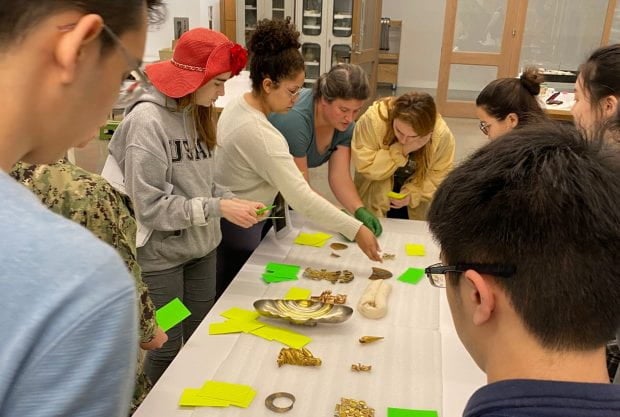As an art history major who’s heading to medical school after graduation, Sid Richardson College senior Naomi Kass was naturally attracted to Chemistry of Art, a popular and long-running Rice course taught by professor of chemistry Ken Whitmire.
“This class is very unique in that it literally combines both science and art, which is kind of like the trajectory of my life in my time at Rice,” Kass said. “And as a senior, I think it kind of sums up my experience almost in a really good way.”
On Jan. 28, Kass and a dozen of her classmates joined Whitmire on a field trip to the Museum of Fine Arts, Houston (MFAH) — one of several during the course, which also makes trips to the neighboring Houston Museum of Natural Science — for a behind-the-scenes look at how conservationists apply chemistry to preserving and restoring pieces of fine art.
In a large, airy room that seemed sunny despite the rain outside, the museum’s assistant conservator of objects and sculpture Ingrid Seyb had laid out a selection of gold and gilded pieces from the archives. Some were in stages of repair, others simply awaiting their turn in the museum’s rotation, including a stunning 6th-century Persian vessel that would have looked at home in 1910-era Vienna.
The MFAH's assistant conservator of objects and sculpture Ingrid Seyb invited Rice students into her workspace for a Chemistry of Art class trip.[/caption]
Soon the students were deep into lessons on the “lost art” of mercury gilding, used extensively by civilizations from Greece and Rome to Persia and China, and ancient depletion gilding methods that employed various acids and resemble modern electroplating. Cleaning and preserving the objects requires an equal amount of chemical knowledge and attention to detail.
“Chemistry is really important for conservation,” Seyb said. “We are let loose on objects with a chemistry lab full of materials, and if you don't understand the consequences that your choices can have, it can really be catastrophic.”
With the MFAH only a 10-minute walk or a train ride from campus, it’s a natural destination for Whitmire’s Chemistry of Art classes ever since he first offered the course in 2005.
It all began with a collaboration between Rice’s Department of Chemistry and the MFAH. Rice provided analytical facilities and support for a large Andrew W. Mellon Foundation grant for conservation research at the museum.
In return, the conservationists help teach the Chemistry of Art course from within their new Sarah Campbell Blaffer Foundation Center for Conservation. The collaboration also includes internships for Rice students and other partnerships for graduates who want to enter the world of art conservation.
“The intent was to offer a very practical course,” Whitmire said. “This is a way of conveying to students who would otherwise have no particular interest in studying science that science actually could be useful for something they are interested in.”
This is precisely what drew Martel College junior Louis Alvares to the course.
“Being that I'm a sport management and psychology major, chemistry was definitely not on my checklist of things to do while I was at Rice,” Alvares said. “But given the fact that Rice is a liberal arts college as well as a research institution, we have the privilege to take classes that are really out of our major.”
The opportunity to see chemistry applied in everyday settings — especially one as interesting as the MFAH — was alluring to both Alvares and Kass.
“This class is really unique in that you can learn something without having to be a Ph.D. in chemistry or physics or biology and actually use that knowledge in the real world,” Kass said. “And so by having that real-world application, it attracts those kinds of people who are more interested in the broader aspects of science and also the arts.
“It's definitely not as intense as just a straight-up intro chem class,” she said.

